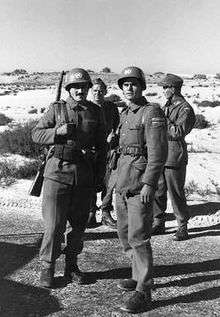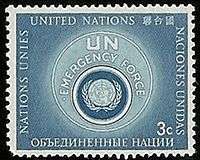United Nations Emergency Force

The first United Nations Emergency Force (UNEF) was established by United Nations General Assembly to secure an end to the Suez Crisis with resolution 1001 (ES-I) on November 7, 1956. The force was developed in large measure as a result of efforts by UN Secretary-General Dag Hammarskjöld and a Nobel Peace Prize-winning (1957) proposal and effort from Canadian Minister of External Affairs Lester B. Pearson. The General Assembly had approved a plan[1] submitted by the Secretary-General which envisaged the deployment of UNEF on both sides of the armistice line.
The Second United Nations Emergency Force (UNEF II) deployed from October 1973 to July 1979.[2]
History
UNEF I
UNEF was the first UN military force of its kind, its mission was to:
- ... enter Egyptian territory with the consent of the Egyptian Government, in order to help maintain quiet during and after the withdrawal of non-Egyptian forces and to secure compliance with the other terms established in the resolution ... to cover an area extending roughly from the Suez Canal to the Armistice Demarcation Lines established in the Armistice Agreement between Egypt and Israel.
UNEF was formed under the authority of the General Assembly and was subject to the national sovereignty clause, Article 2, Paragraph 7, of the U.N. Charter. An agreement between the Egyptian government and the Secretary-General, The Good Faith Accords, or Good Faith Aide-Memoire,[3] placed the UNEF force in Egypt with the consent of the Egyptian government.[4]
Since the operative UN resolutions were not passed under Chapter VII of the United Nations Charter, the planned deployment of a military forces had to be approved by Egypt and Israel. Israel's Prime Minister refused to restore the 1949 armistice lines and stated that under no circumstances would Israel agree to the stationing of UN forces on its territory or in any area it occupied.[5][6] After multilateral negotiations with Egypt, eleven countries offered to contribute to a force on the Egyptian side of the armistice line: Brazil, Canada, Colombia, Denmark, Finland, India, Indonesia, Norway, Poland, Sweden, and Yugoslavia. Support was also provided by United States, Italy, and Switzerland. The first forces arrived in Cairo on November 15, and UNEF was at its full force of 6,000 by February 1957. The force was fully deployed in designated areas around the canal, in the Sinai and Gaza when Israel withdrew its last forces from Rafah on March 8, 1957. The UN Secretary-General sought to station UNEF forces on the Israeli side of the 1949 armistice lines, but this was rejected by Israel.[7]
The mission was directed to accomplish its mission in four phases:
- In November and December 1956, the force facilitated the orderly transition in the Suez Canal area when British and French forces left.
- From December 1956 to March 1957, the force facilitated the separation of Israeli and Egyptian forces and the Israeli evacuation from all areas captured during the war, except Gaza and Sharm-el-Sheik.
- In March 1957, the force facilitated the departure of Israeli forces from Gaza and Sharm-el-Sheik.
- Deployment along the borders for purposes of observation. This phase ended in May 1967.
Due to financial constraints and changing needs, the force shrank through the years to 3,378 by the time its mission ended in May 1967.
On May 16, 1967, the Egyptian government ordered all United Nations forces out of Sinai effective immediately. Then Secretary-General U Thant tried to redeploy UNEF to areas within the Israeli side of the 1949 armistice lines to maintain buffer, but this was rejected by Israel.[8] In a decision that proved to be controversial, Thant acted to effect the Egyptian order without consulting either the Security Council or the General Assembly. Most of the forces were evacuated by the end of May, but 15 UNEF forces were caught in combat operations and killed in the Six Day War. The last United Nations soldier left the region on June 17.
UNEF II

The second United Nations Emergency Forces (UNEF II) was established by United Nations General Assembly, in accordance with United Nations Security Council Resolution 340 (1973), to supervise the ceasefire between Egyptian and Israeli forces at the end of Yom Kippur War or October War, and following of the agreement of 18 January 1974 and 4 September 1975, to supervise the redeployment of Egyptian and Israeli forces and to man and control the buffer zones established under those agreements.[9]
The mandate of UNEF II was to supervise the implementation of United Nations Security Council Resolution 340 which demanded that an immediate and complete ceasefire between Egyptian and Israeli forces be observed and that the parties return to the positions they had occupied at 1650 hours GMT on 22 October 1973. The Force would use its best efforts to prevent a recurrence of the fighting, and in the fulfillment of its tasks it would have the cooperation of the military observers of the United Nations Truce Supervision Organization (UNTSO). UNEF II was also to cooperate with the International Committee of the Red Cross (ICRC) in its humanitarian endeavours in the area. The mandate of UNEF II which was originally approved for six months, until 24 April 1974, was subsequently renewed eight times. Each time, as the date of expiry of the mandate approached, the Secretary-General submitted a report to the United Nations Security Council on the activities of the Force during the period of the mandate. In each of those reports, the Secretary-General expressed the view that the continued presence of UNEF II in the area was essential, and he recommended, after consultations with the parties, that its mandate be extended for a further period. In each case, the Council took note of the Secretary-General's report and decided to extend the mandate of the Force accordingly. In October 1978, the mandate of UNEF II was extended a last time for nine months, until 24 July 1979.[10] The area of operation of the UNEF II was at Suez Canal sector and later the Sinai peninsula, with the headquarters located at Cairo (October 1973 to August 1974) and Ismailia (August 1974 – July 1979).[11] The deployment of forces as of July 1979 was as follows:
- Buffer zone 1 (boundary: Mediterranean sea, line J, line M and line E)
- Swedbatt (Swedish battalion)
- Ghanbatt (Ghanaian battalion)
- Indbatt (Indonesian battalion)
- Bufferzone 2A (boundary: Bufferzone 1, line M, bufferzone 2B, and Gulf of Suez)
- Indbatt (Indonesian battalion)
- Finbatt (Finnish battalion)
- Bufferzone 2B (boundary: bufferzone 2A, line M, Gulf of Suez)
- Finbatt (Finnish battalion)[12]
Strength
- Maximum, February 1974 : 6,973 military personnel, supported by international and local civilian staff
- At withdrawal, July 1979 : 4,045 military personnel, supported by international and local civilian staff.[13]
Force Commanders
UNEF I
Stationed in Gaza City.

- Nov. 1956 – Dec. 1959 Lieutenant-General E. L. M. Burns (Canada)
- Dec. 1959 – Jan. 1964 Lieutenant-General P. S. Gyani (India)
- Jan. 1964 – Aug. 1964 Major-General Carlos F. Paiva Chaves (Brazil)
- Aug. 1964 – Jan. 1965 Colonel Lazar Mušicki (Yugoslavia) (Acting)
- Jan. 1965 – Jan. 1966 Major-General Syseno Sarmento (Brazil)
- Jan. 1966 – June 1967 Major-General Indar Jit Rikhye (India)
UNEF II
- Lieutenant-General Ensio P. H. Siilasvuo (Finland) (October 1973 – August 1975)
- Lieutenant-General Bengt Liljestrand (Sweden) (August 1975 – November 1976)
- Major-General Rais Abin (Indonesia) (December 1976 – September 1979).
Contributing countries
UNEF II
Contributors of military personnel were: Australia (air unit/helicopters and personnel), Austria (infantry), Canada (logistics/ signals air and service units), Finland (troops/infantry), Ghana (troops/infantry), Indonesia (troops/infantry), Ireland (troops/infantry), India (troops/infantry), Nepal (troops/infantry), Panama (troops/infantry), Peru (troops/infantry), Poland (logistics/ engineering medical and transport unit), Senegal (troops/infantry) and Sweden (troops/infantry).[14]
Buffalo 461
On August 9, 1974, Canadian Forces Buffalo 115461 was making a scheduled supply flight from Ismaïlia, Egypt to Damascus, Syria when it was shot down by Syrian surface to air missiles. Nine Canadians were killed, marking the worst ever single day of loss for Canadian peacekeepers.[15] August 9 is today commemorated annually as National Peacekeepers' Day in Canada.[16] A monument to this event has been erected in Peacekeeper Park in Calgary, Canada.[17]
See also
- Multinational Force and Observers, a somewhat similar, but smaller force instituted to ensure enforcement of the Egyptian–Israeli Peace Treaty.
- United Nations Security Council Resolution 340
- United Nations Truce Supervision Organization
- Yom Kippur War
Notes
- ↑ Resolution 1001 (ES-1), 5 November 1956
- ↑ UN.org
- ↑ Good Faith Aide-Memoire, 11 UN GAOR Annexes, Supp. 16 U.N. Doc. A/3375 (1956)
- ↑ The Withdrawal of UNEF and a New Notion of Consent, page 5 Archived July 31, 2012, at the Wayback Machine.
- ↑ Eisenhower and Israel: U.S.-Israeli Relations, 1953–1960, Isaac Alteras, University Press of Florida, 1993, ISBN 0-8130-1205-8, page 246
- ↑ A Restless Mind: Essays in Honor of Amos Perlmutter, Amos Perlmutter, Benjamin Frankel, Routledge, 1996, ISBN 0-7146-4607-5, Michael Brecher Essay, page 104-117
- ↑ Norman G. Finkelstein alludes to Brian Urquhart's memoir, A Life in Peace and War (ISBN 0060158409), where Urquhart, describing the aftermath of the 1956 Suez Crisis, recalls how Israel refused to allow the UNEF to be stationed on the Israeli side of the line, and labels the Israeli rejection as a "grave weakness for a peacekeeping force." (Finkelstein 2003:277)
- ↑ U Thant in his memoir describes how he met permanent representative of Israel to the UN ambassador Gideon Rafael on May 18, 1967 and asked him, "in the event of the United Arab Republic's official request for a UNEF withdrawal, if the government of Israel would be agreeable to permit the stationing of UNEF on the Israeli side of the line..." The ambassador refused, declaring such a proposal was "entirely unacceptable" to his government. U Thant later stated that if only Israel had agreed to permit UNEF to be stationed on its side of the border, "even for a short duration, the course of history could have been different. Diplomatic efforts to avert the pending catastrophe might have prevailed; war might have been averted." (Thant 1978:223)
- ↑ UN site
- ↑ UNEF II mandate Archived September 12, 2009, at the Wayback Machine.
- ↑ United Nations Department of Public Information: Middle East – UNEF II
- ↑ The Blue Helmet, A Review of United Nations Peace-Keeping, United Nations Publication, second edition, 1990, pp 423. ISBN 92-1-100444-6.
- ↑ Middle East – UNEF II facts and figures
- ↑ The Blue Helmet, A Review of United Nations Peace-Keeping, United Nations Publication, second edition, 1990, appendix III Maps. ISBN 92-1-100444-6.
- ↑ Buffalo 461 webpage
- ↑ Veteran's Affairs Canada website
- ↑ CBC news story
References
- Finkelstein, Norman G. (2003). Image and Reality of the Israel-Palestine Conflict, 2nd ed., New York: Verso. ISBN 1-85984-442-1.
- Oren, Michael B. (2002). Six Days of War: June 1967 and the Making of the Modern Middle East, New York: Ballantine Books. ISBN 0-345-46192-4.
- Rikhye, Indar Jit (1980). The Sinai Blunder, London: Frank Cass. ISBN 0-7146-3136-1.
- Thant, U (1978). View from the UN, New York: Doubleday & Company, Inc. ISBN 0-385-11541-5.
External links
- Yearbook of the United Nations, 1956, THE PALESTINE QUESTION (DECEMBER 1955-OCTOBER 1956)
- United Nations history of UNEF
Further reading
- The Sinai peace front : UN peacekeeping operations in the Middle East, 1973–1980, by Bertil Stjernfelt London : Hurst ; New York : St. Martin's Press, ©1992 ISBN 1-85065-090-X
- The United Nations' peacekeeping operations in the Arab-Israeli conflict : 1973–1979, by Doran Kochavi, Ann Arbor, Mich. : University Microfilms, 1984. OCLC Number: 229042686